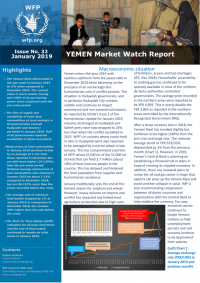Yemen Market Watch Report, Issue No. 32 (January 2019)
Highlights
• The Yemeni Riyal depreciated in the last week of January 2019 by 3% when compared to December 2019. The current value is much weaker having lost 148% of its purchasing power when compared with the pre-crisis period.
• The flow of supply and availability of basic food commodities at local markets in all governorates (except Hudaydah and Socotra) persisted in January 2019. Half of all governorates reported availability of diesel and petrol.
• Retail prices of food commodities in January 2019 declined further by an average of 1-3% from those reported in December but are still much higher (33-139%) than the pre-crisis period.
National average retail prices of fuel commodities also reduced in January 2019 by about 2-13% compared to December 2018; but are 98-132% more than the prices recorded before the crisis.
• The average cost of minimum food basket dropped by 1% in January 2019 in comparison to December 2018, but remains 96% higher than the cost before the crisis.
• The Alert for Price Spikes (ALPS) indicators for all basic food items and the cost of food basket continued to remain on crisis levels in January 2019.
Macroeconomic situation
Yemen enters the year 2019 with cautious optimism from the peace talks in December 2018 while balancing on the precipice of an increasingly dire humanitarian crisis if conflict persists. The situation in Hudaydah governorate, and in particular Hudaydah City remains volatile and continues to impact commercial and non-commercial imports.
As reported by OCHA’s Issue 2 of the Humanitarian Update for January 2019, volumes discharged at Hudaydah and Saleef ports have now dropped to 20% less than when the conflict escalated in 2015. WFP’s In-country wheat stocks held in silos in Hudaydah were also reported to be damaged by a mortar attack in late January. This has compromised a portion of WFP wheat (4,500 mt of the 51,000 mt stored) that can feed 3.7 million (about 18%) of food insecure people in the country. This has delayed and hindered the local population from supplies and humanitarian assistance.
January traditionally sees the end of the harvest season for sorghum and wheat. However, heavy reliance on imports and conflict has impacted and halted most agriculture production due to high costs of fertilizers, access and fuel shortages (IPC, Dec 2018). Households’ accessibility to cooking gas has continued to be sparsely available in most of the northern de-facto authorities controlled governorates. The average price recorded in the northern areas were reported to be YER 4,992. This is nearly double the YER 2,865 as reported in the southern areas controlled by the Internationally Recognized Government (IRG).
After a sharp recovery late in 2018, the Yemeni Riyal has receded slightly but continues to be higher (148%) than the pre-crisis exchange rate. The national average stood at YER 533/USD, depreciated by 3% from the previous month (Chart 1). However, in 2019, Yemen’s Central Bank is planning on establishing a financial hub in Aden in hope of reviving its crippled economy. In addition, there are renewed plans to revive the oil and gas sector in hope that exports can prop up the Yemeni Riyal and avoid another collapse in value. IMF is also recommending cooperation between all donor countries and organisations with the Central Bank to help stabilize the currency. For now, economic access continues to hinder Yemeni civilians as high unemployment persists and civil servants continue to be deprived of their salaries.
https://reliefweb.int/report/yemen/yemen-market-watch-report-issue-no-32-january-2019


